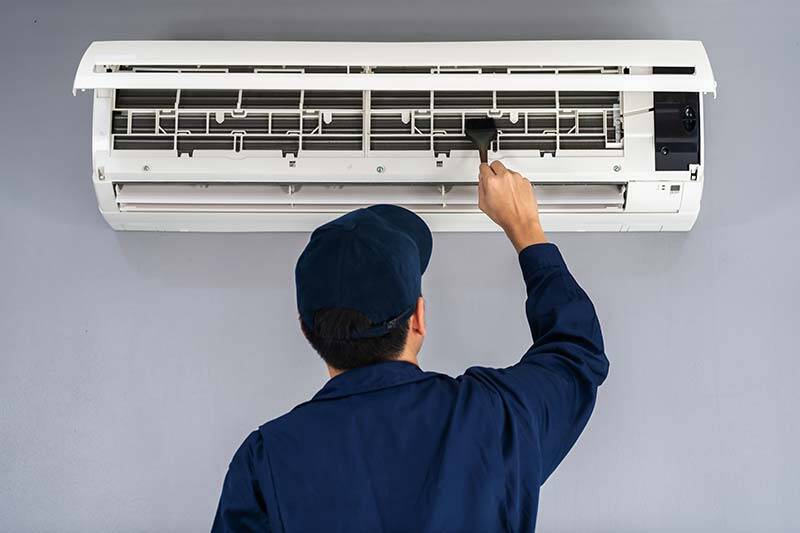WHAT IS AN AIR CONDITIONER:
On a hot summer day, there are few appliances which are life-saving. Air Conditioners are one of such devices. AC’s are the miracle of engineering that pumps heat from one side to another, shifting the heat to the outside and circulating wonderful cool air inside. And they do this in a remarkably small space, often without having to knock holes in your walls. So, how do these miracles of cool work? Fundamentally, a window AC unit is a pump, one that shifts heat instead of water. It does this by using a chemical that turns from a liquid into a gas with a relatively small shift in pressure. Called a phase transition, this process is at the heart of how AC units work.
HOW DOES IT WORKS:
When the pump is active (which you can usually hear; it’s the low-frequency rumble from a working AC), it’s compressing the coolant so it becomes a liquid. This liquid passes through the outside radiator, where it sheds heat into the outside air. When it reaches the expansion valve, only a small amount is let through, so the pressure on the other side is much lower. This makes the coolant evaporate, which cools it down. From there, it passes through the inside radiator, and the air passing over this is cooled. The coolant absorbs the energy (the heat) from the air inside the room, cooling it. The coolant then moves into the pump, where it is compressed again and pushed into the outside half of the loop, and the process repeats. The whole process is controlled by a computer that measures the temperature of the air being sucked into the unit and turns the pump on and off as required. Because the coolant takes time to pass through the expansion valve, the pump doesn’t run all the time when the unit is cooling: when the pressure on the hot, outside part of the loop reaches a certain level, the controller turns the pump off until the pressure falls. As the coolant passes through the pressure valve, it evaporates and cools in the inside radiator, and you feel the cool air. That’s why you don’t feel an immediate rush of cool air when you turn on a window AC unit: the pump has to build up the pressure before the cooling can begin.
PROCEDURES TO MAINTAIN YOUR AIR CONDITIONER:
Keep your air-conditioner (AC) maintained to save your money and time as well by doing simple maintenance steps you will also extend its lifespan, saving money on costly early replacement. An AC needs regular attention to be sure it’s operating at the highest efficiency.
1.SHUT OFF THE POWER
Electricity and human contact doesn’t go well so always remember to switch off the power before carrying out any maintenance. The electricity should remain off until you are done with the maintenance work
2.REMOVE DEBRIS AND CLEAN FINS
On the outdoor unit look for any unwanted materials such as debris or small plants and leaves and remove them carefully. You can also wash down the outdoor unit with a garden hose and spray water over the fins in order to remove accumulated dust and dirt.
3.STRAIGHTEN THE FINS AND CLEAN THE AREA AROUND
Bent and mis-shape fins can obstruct the efficient movement of air. Make sure the fins are straight, for minor deformations you can carefully straighten them, but if you’re not sure please call us for advice first. Make sure the area around the outdoor unit is free from plant growth and there is unrestricted air-flow near the fan and fins.
4.CLEAN THE EVAPORATOR DRAIN
On the interior side warm, humid air from your home’s atmosphere is blown through the evaporator coil. The cold coil absorbs heat from the air, cooling it before the air is circulated back into your home. The humidity in the air condenses on the cool surface of the evaporator coil as liquid water, dripping into a pan below. From the pan, the water flows into a drain tube which is typically routed into a basement floor drain, utility sink, or outdoors. Over time, algae and mold can build up and clog the drain, So if the water is not flowing or flowing freely the drain will need to be cleared. The drain is usually a one-inch PVC pipe (white, grey, or black). Follow it to the end where it drains. Often the line drains outside near the condenser unit. Once located, use a wet/dry vacuum to clear the drain.
5.CHANGE THE BLOWER FILTER
The filter in your HVAC system should be changed at least twice a year – once just before the heating season begins and once before the cooling season begins. If you live in a particularly pollution prone area, you may want to change it more often. Always replace the filter with a new filter that has the same airflow rating.
OLD AND MODERN REFRIGERANTS :
Refrigerants make air conditioning possible. Contained within the coils of an air conditioner, these liquid agents cool and dehumidify indoor air. For years, the most common refrigerant gas used in air-conditioning was R22 freons. Today, the major brands have introduce new innovations due to consideration of environmental concerns. Production of systems using R-22 refrigerant is being phased out. Meanwhile, cooling systems have introduced an environmentally friendly alternative to R-22. EPA has recognized chlorine-free R410A refrigerant Because R-410A contains no chlorine, it is considered ozone-friendly. Highest efficiency cooling systems are designed to use R-410 A refrigerant, therefore providing an economic benefit in addition to the environmental benefit. R-410A systems are also known for improved reliability, quieter operation, improved dehumidification, and enhanced heat pump performance.
The main Features of R-410A are :
· R-410 A is a hydro-fluorocarbon ( HFC ) & doesn’t contribute to ozone depletion.
· its operating pressures are 50% higher than R – 22
· R410 requires components capable of working at these high pressures
· It is the most common refrigerant for new light commercial unitary AC’s.

